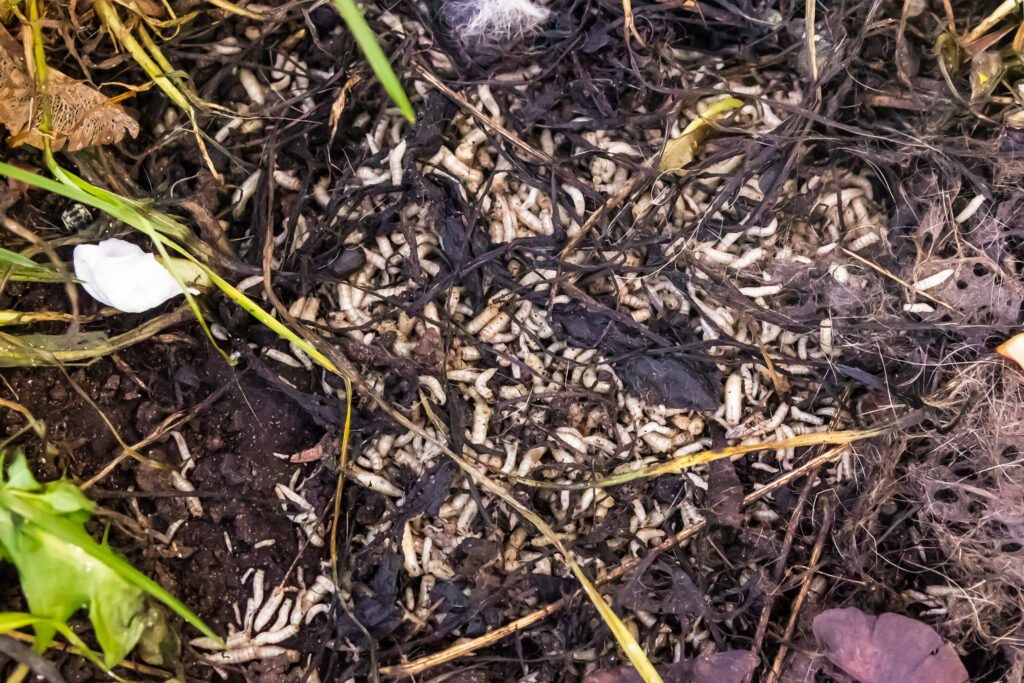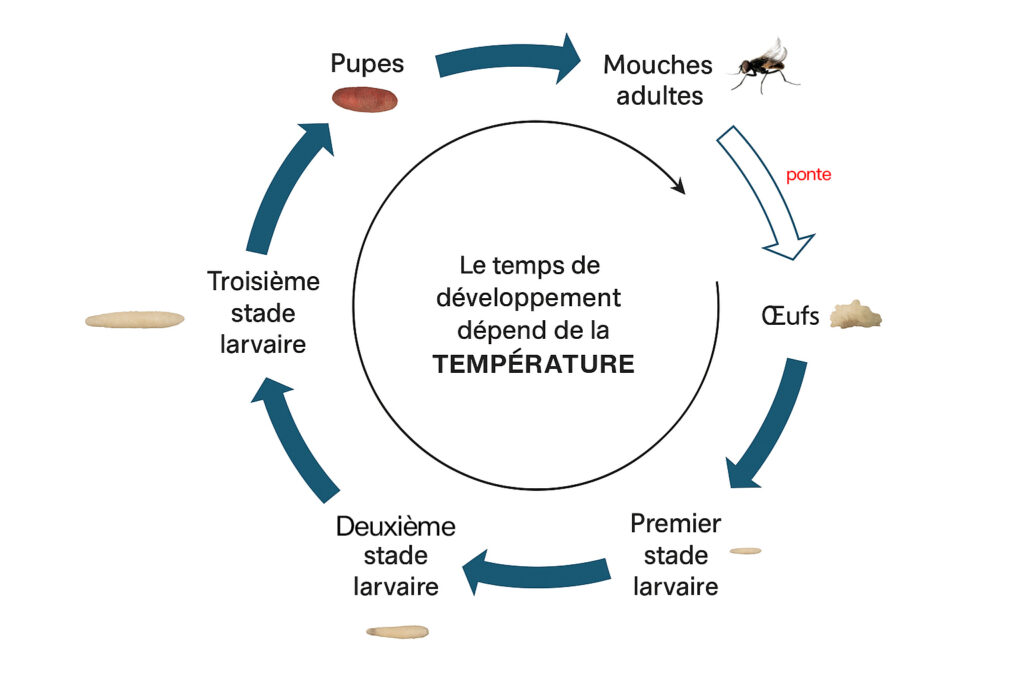When the body no longer speaks, insects tell the truth. At the crossroads of toxicology and entomology, entomotoxicology turns these small organisms into key witnesses capable of revealing what time seeks to erase.
The increasing number of drug-related deaths—whether caused by accidental ingestion, overdose, or suicidal poisoning—has generated growing interest in forensic medicine. As its name suggests, entomotoxicology lies at the intersection of toxicology and entomology, two disciplines that provide crucial elements to the establishment of the truth in the justice system. Entomotoxicology fulfills two main roles: it relies on the potential of insects to serve as indicators of toxic substances present in decomposing tissues, and it studies the impact of these substances on arthropod development. This dual function allows for more accurate forensic estimates of the postmortem interval (PMI), i.e., the time elapsed between death and the discovery of the body. Insects—particularly blowfly larvae—thus become valuable subjects for analysis.
Insects serving the truth
In certain deaths, especially those linked to drug abuse or suicide, the victim’s body may remain undiscovered for several days or even months. Decomposition begins immediately after death, releasing gases and fluids that produce putrefaction odors. These effluents quickly attract insects such as flies, which lay their eggs in the body’s natural openings. The emerging larvae feed on the decomposing flesh, thereby accelerating the breakdown process [Forensic Entomology – Damien Charabidze].
As insect colonization progresses, it further accelerates the gradual decomposition of body tissues. This degradation also alters organic fluids and tissues such as urine, blood, and the liver, rendering traditional matrices used in forensic toxicological analyses unavailable or unreliable. At this stage, insects—particularly blowfly larvae—become especially valuable for toxicological examination.

Because of their abundance, ease of collection, and resistance to environmental conditions, necrophagous insect larvae can be sampled from various regions of the body where they are present. This choice is critical, as the ante- and postmortem redistribution of substances (medications, drugs, toxins) within the body may vary between tissues, leading to qualitative and quantitative differences in the insects. Collecting multiple samples from different area therefore improves the accuracy and reliability of qualitative results. Numerous studies have demonstrated their potential to reveal toxic substances where traditional methods have failed [1–4]. To date, entomotoxicological analyses allow only for the qualitative detection of toxic substances present in the decedent’s body. This means that one can confirm the presence or absence of a drug, poison, or medication in the tissues consumed by the larvae, but not yet reliably determine its concentration.
Such results can therefore only support a hypothesis of intoxication. However, establishing whether the detected quantity was lethal is not yet possible, as this would require a more reliable quantitative approach.
In addition, the toxicologist must bear in mind that these small organisms are capable of metabolizing substances and producing metabolites similar to those generated by the human body, despite the usual complexity of such biotransformations in humans. Research into this phenomenon is still in its early stages.
Forensic entomological methods can assist in determining the minimum time elapsed between death and the discovery of the body.
Drugged insects, misleading dating!
In a criminal investigation, a key factor to consider—especially in cases involving decomposed bodies—is the minimum postmortem interval (minPMI). This refers to the time elapsed between the moment when the first insects colonized the body and its discovery (Fig. 1).

It is referred to as a minimum because this estimate does not begin at the exact time of death but at the moment of the first insect colonization, which occurs shortly after death, ranging from a few minutes to several hours depending on environmental factors. Once rigor mortis, livor mortis, and the cooling of the body to ambient temperature have passed, it becomes increasingly difficult to estimate the time elapsed since death. The body then enters the putrefaction phase, during which forensic entomological methods can assist in determining the minimum time elapsed between death and the discovery of the body.
However, if the victim had consumed drugs prior to death, this can significantly affect the development of necrophagous insects by accelerating or delaying their growth.
Forensic entomologists measure the size and study the developmental stage of the larvae present on the body, and by taking into account factors such as ambient temperature, the insect species identified, and data on necrophagous species succession [5, 6], they compare these findings with the life cycle of the insects concerned (Fig. 2).

Since certain species colonize a cadaver very soon after death, they make it possible to determine the day of initial colonization and thereby estimate a minimum postmortem interval (minPMI).
However, if the victim had consumed drugs prior to death, this can significantly affect the development of necrophagous insects by accelerating or delaying their growth. Comparison with their life cycle is therefore biased, leading to overestimation or underestimation of the minPMI. This is why studies have been conducted to evaluate the impact of specific drugs on insect development, with the aim of eventually incorporating these variability ranges into more accurate minPMI estimations [7–12]. The way in which insects metabolize or fail to metabolize ingested toxic substances remains uncertain.
Limitations of entomotoxicology
Although insects can provide valuable information, entomotoxicology is not without limitations.
First, the environment plays a critical role: insect development is highly dependent on temperature, humidity, and climate. If the body is, for example, exposed to extreme heat or strong winds, insect colonization may differ. Ambient temperature directly influences insect survival and development. Harsh environmental conditions may kill the insects or slow their growth, thereby biasing or preventing analysis.
Moreover, beyond development, insect colonization itself can also be disrupted. For instance, when a body is submerged in water or covered (by clothing, tarpaulins, soil, debris, etc.), insect access is hindered. This may alter the dynamics of colonization and consequently the way insects feed on the body.
Another challenge in entomotoxicology is the uncertainty regarding how insects metabolize or fail to metabolize toxic substances they ingest. Unlike humans, their metabolism and the ways in which they store or eliminate toxic substances are poorly understood. As a result, it is difficult to establish a correlation between the amount of toxic substances detected in insects and the dose ingested by the deceased, making it problematic to confirm a lethal dose in the body and therefore to substantiate and accept a prior hypothesis of fatal intoxication.
Furthermore, methods for extracting, purifying, and analyzing toxic substances in insect larval tissues are not yet standardized. Each study must be adapted according to the substances being investigated.
Conclusion
Forensic entomotoxicology thus illustrates how insects could in the future become key witnesses in the resolution of criminal investigations. It opens up promising perspectives for forensic medicine by broadening the range of possibilities when no other biological sample is available. With advances in research, entomotoxicology may become an even more precise tool—not only qualitative but also quantitative—and essential in contributing to the establishment of truth in real forensic casework.
Bibliographie :
- [1] Campobasso, C., Gherardi, M., Caligara, M., Sironi, L., & Introna, F. (2004c). Drug analysis in blowfly larvae and in human tissues : a comparative study. International Journal Of Legal Medicine, 118(4). https://doi.org/10.1007/s00414-004-0448-1
- [2] Groth, O., Franz, S., Fels, H., Krueger, J., Roider, G., Dame, T., Musshoff, F., & Graw, M. (2021). Unexpected results found in larvae samples from two postmortem forensic cases. Forensic Toxicology, 40(1), 144‑155. https://doi.org/10.1007/s11419-021-00601-x
- [3] Levine, B., Golle, M., & Smialek, J. E. (2000b). An unusual drug death involving maggots. American Journal Of Forensic Medicine & Pathology, 21(1), 59‑61. https://doi.org/10.1097/00000433-200003000-00010
- [4] Beyer, J., Enos, W., & Stajić, M. (1980b). Drug Identification Through Analysis of Maggots. Journal Of Forensic Sciences, 25(2), 411‑412. https://doi.org/10.1520/jfs12147j
- [5] Lutz, L., Verhoff, M. A., & Amendt, J. (2018). Environmental factors influencing flight activity of forensically important female blow flies in Central Europe. International Journal Of Legal Medicine, 133(4), 1267 1278. https://doi.org/10.1007/s00414-018-1967-5
- [6] Matuszewski, S. (2021). Post-Mortem Interval Estimation Based on Insect Evidence : Current Challenges. Insects, 12(4), 314. https://doi.org/10.3390/insects12040314
- [7] Boulkenafet, F., Dob, Y., Karroui, R., Al-Khalifa, M., Boumrah, Y., Toumi, M., & Mashaly, A. (2020). Detection of benzodiazepines in decomposing rabbit tissues and certain necrophagic dipteran species of forensic importance. Saudi Journal Of Biological Sciences, 27(7), 1691‑1698. https://doi.org/10.1016/j.sjbs.2020.04.044
- [8] Gosselin, M., Di Fazio, V., Wille, S. M., Del Mar Ramírez Fernandez, M., Samyn, N., Bourel, B., & Rasmont, P. (2011b). Methadone determination in puparia and its effect on the development of Lucilia sericata (Diptera, Calliphoridae). Forensic Science International, 209(1‑3), 154‑159. https://doi.org/10.1016/j.forsciint.2011.01.020
- [9] El-Samad, L. M., El-Moaty, Z. A., & Makemer, H. M. (2011). Effects of Tramadol on the Development of Lucilia sericata (Diptera : Calliphoridae) and Detection of the Drug Concentration in Postmortem Rabbit Tissues and Larvae. Journal Of Entomology, 8(4), 353‑364. https://doi.org/10.3923/je.2011.353.364
- [10] Bourel, B., Hédouin, V., Martin-Bouyer, L., Bécart, A., Tournel, G., Deveaux, M., & Gosset, D. (1999). Effects of Morphine in Decomposing Bodies on the Development of Lucilia sericata (Diptera : Calliphoridae). Journal Of Forensic Sciences, 44(2), 354‑358. https://doi.org/10.1520/jfs14463j
- [11] Zou, Y., Huang, M., Huang, R., Wu, X., You, Z., Lin, J., Huang, X., Qiu, X., & Zhang, S. (2013). Effect of ketamine on the development of Lucilia sericata (Meigen) (Diptera : Calliphoridae) and preliminary pathological observation of larvae. Forensic Science International, 226(1‑3), 273‑281. https://doi.org/10.1016/j.forsciint.2013.01.042
- [12] O’Brien, C., & Turner, B. (2004). Impact of paracetamol on Calliphora vicina larval development. International Journal Of Legal Medicine, 118(4), 188‑189. https://doi.org/10.1007/s00414-004-0440-9
Tous droits réservés - © 2025 Forenseek


















